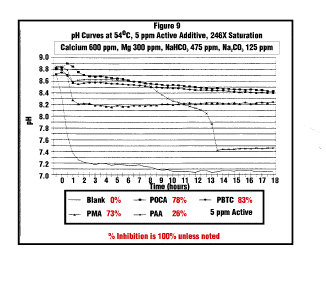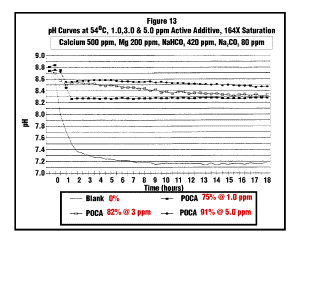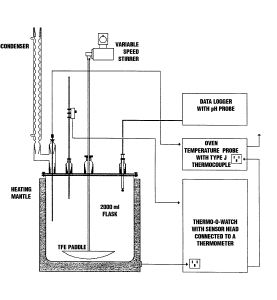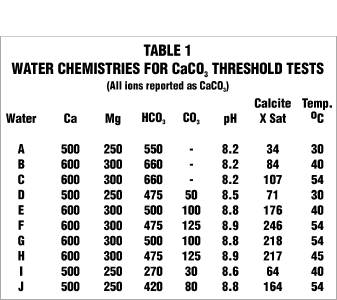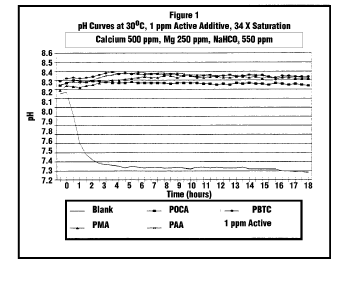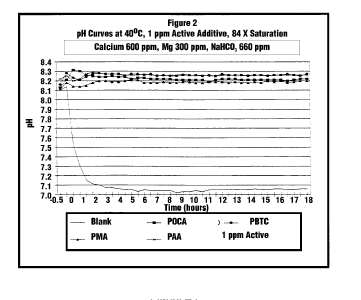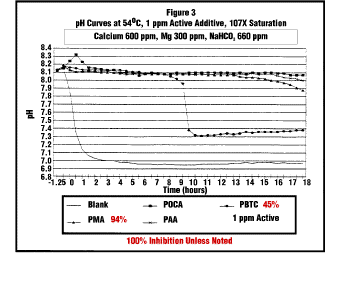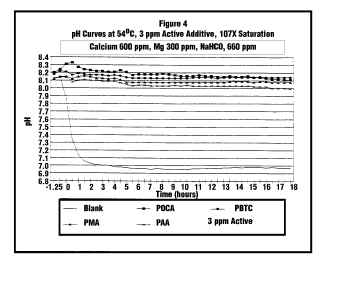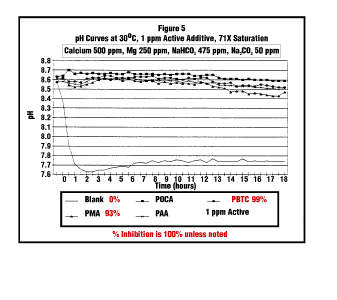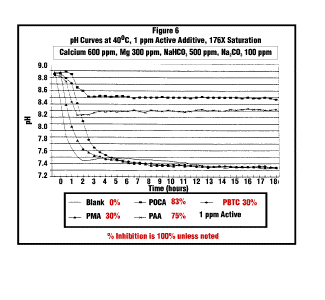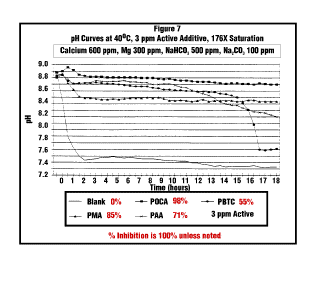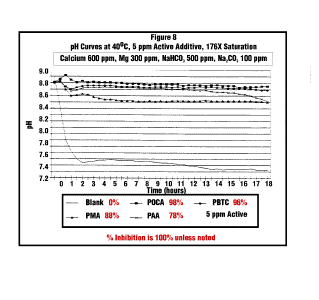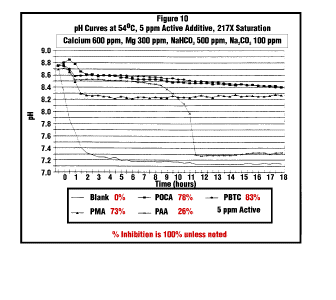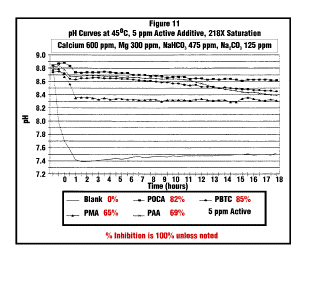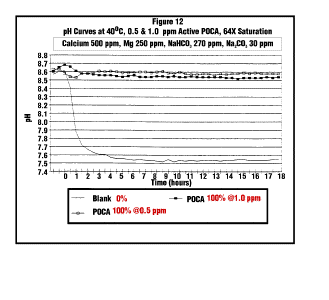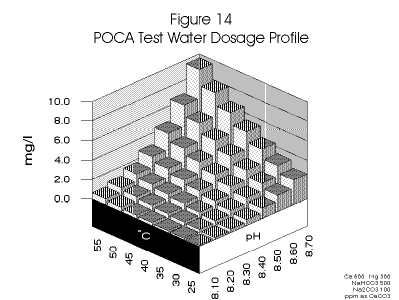French Creek Software | Scale & Corrosion Software Tools
A MULTIFUNCTIONAL ADDITIVE FOR DEPOSIT
CONTROL
Patrick J. Sullivan, Frank O'Brien
FMC Corporation, Princeton, New Jersey
Robert J. Ferguson
French Creek Software, Kimberton, Pennsylvania
Presented at CORROSION 96, Paper No. 158
The NACE International Annual Conference and Exposition
ABSTRACT
Laboratory studies were conducted to profile the performance of a new scale
inhibitor and to compare its performance to commonly used inhibitors. A
software package was used to optimize the experimental design and minimize
the number of test required to develop a complete performance profile.
This paper outlines the results of the study.
Keywords: Calcium carbonate, scale inhibitor, modeling, software.
INTRODUCTION
During the past decade, a trend that has dominated the industrial cooling
water market has been ways to reduce water consumption. In many areas of
the country this results in the operation of open cooling systems with
longer half life, higher cycles of concentration and an increased CaCO3
scaling tendency of the water. Depending on the size and the economic impact
on the system mechanic as well as chemical approaches are often considered.
In order to efficiently operate an industrial cooling system, it is essential
to have an effective chemical treatment program in place. Operations under
alkaline conditions require programs that can minimize scaling due to sparingly
soluble inorganic salts, and reduce or inhibit fouling from suspended solids
or corrosion by-products.
To facilitate the successful application of a formulated chemical treatment
program the service company must be able to predict the performance of
the program relative to the environment under treatment. Perhaps the most
accurate, but tedious method to accomplish this is the development of an
application window based on past performance for specific conditions, cumulative
file accounts of physical parameters and water chemistries. The information
can be further refined by correlation to indices ranging from simple estimates
of calcium carbonate scale potential ( such as the indices developed by
Langelier1, Ryznar2 or Puckorious), to driving forces
calculated by rigorous methods which account for ion interaction and common
ion effects.
This approach has given way to utilization of software programs which
can calculate the scaling potential of ions present in the process water
through the previous mentioned method, and the saturation index for specific
salts. Saturation level based indices describe the ratio of the current
water chemistry to water chemistry expected to a particular scalant. The
classic saturation ratio is defined as the ratio of the ion activity product
(IAP) to the solubility product 3(Ksp).
saturation ratio = IAP/Ksp
In the case of calcium carbonate this equates to:
saturation ratio = [Ca observed][CO3 observed]/Ksp calcite
Various degrees of sophistication can be applied to this calculation,
taking into account ion pairings, and simultaneously calculating the "scaling"
potential of the water for the appropriate species present4.
Extending this concept, software has been developed that can extrapolate
the activity of additives for threshold inhibition of inorganic salts,
based on performance data generated in the lab and/or field5.
Models are developed by the program which predict minimum effective dosage
as a function of select variables such as water chemistry time and temperature.
These models have proven useful in providing dosage guidelines for the
treatment of operating cooling systems. As with all software, the effectiveness
of the models is directly dependent upon the quality of the data input.
Theoretically, this method should highlight the most effective individual
additives for scale inhibition. In examining performance limitations it
should be possible to suggest preferred chemistries that can extend the
application window for CaCO3 deposit control. Additives used
in IWT for deposit control fall into two distinct categories: threshold
inhibitors and dispersants, based on phosphonates and carboxylic acid polymers
respectively. In cooling water formulations these two chemistries complement
each other, resulting in a combination that exhibits good activity in alkaline
environments for CaCO3 control. However, the deposit control
properties of the phosphonates and polymers are not entirely exclusive.
It has been well documented that polymers have some threshold inhibition
activity6. The combination of inhibitors with threshold and
dispersant mechanisms has been used to successfully extend the useful performance
range for CaCO3 deposit control. Typical combinations include
polymaleic acid, PMA, with hydroxy ethylene
di- phosphonic acid, HEDP, and PMA with phosphono
butane tri-carboxylic acid, PBTC.
IWT environments can compromise the performance of formulated products
in a number of ways. In situations where high cycles and reduced blow down
dictate operations, hardness and alkalinity can act as a ceiling for these
programs7. An approach that has often been considered, but not
applied until recently was the combination of the active functional groups
for CaCO3 control from polymers and phosphonates into one molecule.
This material , phosphono carboxylic acid, (POCA)
, represents a change from optimizing activity for specific scale problems8,
to appreciably improving overall alkaline deposit control9.
Lab work under accelerated conditions shows that POCA exhibits good
calcium tolerance, and dispersancy properties often associated with polymers.
It also exhibits good stability towards halogen based oxidizing biocides.
Process and bench testing suggest it behaves similar to phosphonates by
inhibiting CaCO3 precipitation and providing ferrous metal corrosion
control10.
From this initial series of test several issues needed resolution, including
qualifying POCA's activity as a CaCO3 threshold inhibitor under
alkaline conditions. In order to proceed with this work, a bench test was
develop that would incorporate many of the variables encountered in open
cooling system that can influence CaCO3 precipitation. Watercycle®
software was utilized to develop an experimental matrix for investigating
additive activity as threshold inhibitors.
EXPERIMENTAL
Static bench tests for CaCO3 threshold inhibition
are useful methods to establish additive performance trends for cooling
water applications. Advantages this method enjoys are frequency of test,
quantity of test, and ease of set up. Most tests of this type are conducted
in sealed or capped vessels and arranged in a constant temperature hot
water bath. Limitations with this approach are that the tests are stagnant
in nature, and the sealed cap prevents the normal exchange of gases, i.e.
CO2, that occurs in an open cooling system. This environment
can arrest the CaCO3 precipitation reaction, resulting in an
appreciably different environment than real cooling systems.
In attempting to mimic field conditions fluid dynamics and equilibrium
with the atmosphere should be considered. The equipment design developed
for this study incorporates these two parameters to more closely simulate
the cooling water environment utilizing bench testing. Diagram
1 is a schematic of the test unit used in this study. Each unit consists
of a two liter Pyrex® vessel with four openings (ground glass to minimize
loss on evaporation). The openings are fitted with A) water cooled condenser
to minimize water loss due to evaporation, B) glass stir shaft with a Teflon®
paddle for mixing attached to a variable speed motor, C) pH/temperature
probe connected to a data logger set for readouts every 30 minutes, D)
thermometer fitted with a temperature sensing head connected to a Therm-O-Watch®
for constant temperature control. The reaction vessel was placed in an
enclosed heating mantle, with heat output regulated via the TOW.
Testing was conducted on a matrix developed by the software program.
Six different water conditions listed in Table
1 (A-F) were used in the initial evaluation. Separate stock solutions
were prepared on a weekly basis for calcium, magnesium, bicarbonate, carbonate
and four additives. System chemistries were prepared in the 2 liter flask.
Order of addition was DI water, followed by the appropriate concentration
of additive, calcium, magnesium, bicarbonate and where required carbonate.
All ion concentrations are as CaCO3, all additives were evaluated
on an actives basis.
Upon addition of the additives and the ions to the reaction vessel the
variable speed motor for the stir rod was turned on. The TOW device which
was connected to the thermometer assured constant temperature by regulating
the output from the variac once the testing temperature was achieved. Based
on the different temperatures for each condition, attainment of system
water temperature varied. Time 0 is when the system reached testing temperature,
the (-) time on the graphs is the heating period.
Throughout the test pH and system temperature values were recorded via
the data logger which was wired to the pH/temperature probe. By utilizing
the data logger for pH output, additive failure could be tracked back to
a specific time. Information generated was reported on graphs (figure
1-13), time vs. pH. In the bench systems, whether they be open (as
in this set-up) or closed (bottles capped or sealed) there is a finite
quantity of reactive material. As the alkalinity reacts with the calcium,
it will form a complex. Depending on the concentration of materials present
the CaCO3 solubility may be exceeded, both calcium and alkalinity
(CO3-2, HCO3-) will be depleted
through the precipitation of this salt. The decrease in alkalinity will
result in corresponding reduction in pH.
Test duration was 18 hours. Upon termination samples are filtered through
a 0.22 micron filter and titrated for hardness. Percent inhibition is determine
using the following equation with the appropriate concentrations:
- % inhibition = [Ca ( conc. treated solution)- Ca (control)]/[ Ca (initial)- Ca( control)] x 100
RESULTS AND DISCUSSION
The purpose of the bench testing was to investigate the activity of POCA as a CaCO3 threshold inhibitor and develop a dosage profile. In order to get a better gauge of POCA's performance comparison testing was conducted vs. three popular additives utilized in alkaline environments for CaCO3 control . The additives represent a diverse range of chemistries and through serendipity, mechanisms for deposit control in cooling water. Additives used for deposit control function by three different mechanisms, threshold inhibition, dispersancy and crystal modification. The three additives chosen for the investigation excel in one of these areas were:
- PBTC, a phosphonate that is generally recognized as the most effective CaCO3 threshold inhibitor for cooling water systems operating in which both calcium and alkalinity concentrations are in excess of 500ppm as CaCO3
- A low molecular weight poly- acrylic acid, PAA, which exhibits good dispersancy characteristics, inhibiting CaCO3 deposition on the operational components of the cooling systems
- A low molecular PMA. PMA's ability to distort and disrupt crystal lattices of CaCO3 has been well documented through Scanning Electron Microscope images of CaCO3 precipitated out of solution in the presence of PMA11. The PMA absorbs on the face of a growing crystal, disrupting the crystal morphology, inhibiting the formation of well defined geometric crystal lattices of CaCO3 . This property also assists in the dispersancy of CaCO3 precipitated from solution.
As this series of test demonstrates, the threshold inhibition property
is not exclusive to phophonates alone. All additives used for deposit control
in cooling water systems exhibit some activity by a combination of these
three mechanisms to varying degrees.
To establish the activity of the additives for CaCO3 threshold
inhibition it was necessary to evaluate the materials under a broad range
of water parameters. In order to expedite the process, computer software
was utilized to assist in developing a testing matrix. Six different conditions
were used for this evaluation to develop a dosage profile of the materials
tested.
In the first phase of testing work concentrated on investigating the
influence of hardness and temperature. The alkalinity contribution was
limited to HCO3 -, which resulted in a system pH
considerably lower than what would be found in the field. The CaCO3
saturation ratio index ranged from 34 -107 times saturation. In the second
series of tests both hardness and temperature remained the same, but the
alkalinity was made up with both HCO3- and CO3
-2. This caused a considerable increase in the CaCO3
saturation, in waters C,D,E, from 71 to 246. Upon completion of the initial
matrix developed for the dosage profile two other conditions were tested
to qualify the activity of POCA (G,H), followed by testing based on dose
projections from the software program(I,J).
Test water A had a relatively low CaCO3 saturation index
due to the mild water temperature. Since the alkalinity contribution was
all HCO3- the system pH remained less than 8.3. Still
the control showed a significant loss of calcium, over 150ppm. The pH curve
plots for this condition (Figure 1) highlights the effectiveness of the
additives relative to the control. The control had a significant pH drop
due to the precipitation of CaCO3 and the loss of alkalinity.
For the evaluation using water B, the hardness and alkalinity contributions
were increased to 600 and 660 respectively. Water temperature was more
representative of bulk water temperatures for typical light industrial
application, 40C, and the CaCO3 saturation index increased to
84. As would be expected for the control, in the abscence of an inhibitor
a considerable amount of calcium, 280ppm, precipitated. The pH curve tracks
the CaCO3 precipitation, Figure
2. All four additives inhibited CaCO3 precipitation at 1
ppm actives. The 10 degree increase in the bulk water temperature did not
have an adverse effect on additive performance.
As testing progressed to condition C, only one parameter was changed,
temperature increase to 54C. This increased the CaCO3 saturation
ratio to 107. It has generally been accepted that as applications approach
saturation ratios of 120, the conditions can exceed additives ability to
maintain soluble chemistry. In this environment a differentiation in performance
was exhibited, Figure 3 . Both
POCA and PAA maintained 100% soluble chemistry. The performance of PMA
was reduced, but it still exhibited good activity tailing off after 13
hours. PBTC experienced a significant drop in performance eight hours into
the test. It apparently extended the "induction period" for CaCO3
crystal growth compared to the control by blocking primary active crystal
growth sites. Crystal nucleation did however continue at a slower rate
until the PBTC concentration was exhausted, and CaCO3 precipitation
continued at a noticeable rate. This behavior has been well documented
in literature describing pH stat methods to study the kinetics of precipitation
for CaCO312, and Ca3 (PO4)213.
Previous research investigators have reported that at low concentrations
PBTC's activity can be somewhat suppressed14. PBTC requires
reaching a minium "threshold" concentration before activity is
established. Below that concentration performance can be suspect. Increasing
the additive concentration to 3 ppm results in 100% CaCO3 threshold
inhibition being achieved, as shown in figure
4.
In the next stage of testing, the alkalinity contribution was made up
with both HCO3- and CO3 -2.
Water temperature and total hardness remained the same. The CO3-2
contribution expanded the CaCO3 saturation index investigated
from a relatively moderate 71 to a severe index of 246. This was to facilitate
the development of an accurate dosage profile from a limited number of
points for a range of conditions.
At 30C water D was tested (500 Calcium, 250 Magnesium ppm) which had
a total alkalinity of 525ppm contributed by 475 HCO3-
and 50ppm CO3-2. The calculated saturation ratio
was 71. Figure 5, traces system
pH for the additives, and would suggest that activity for the PMA, PAA
and PBTC drifted relative to POCA. With the exception of PMA all of the
additives exhibited 100% inhibition, and PMA deviated only slightly, inhibiting
96% CaCO3 precipitation .
Progressing to the next stage, water E had a system temperature of 40C,
calcium hardness of 600ppm and an alkalinity of 600ppm (500ppm HCO3-
and 100ppm CO3-2). Under these conditions the saturation
index jumped to 176. 1 ppm active additive was insufficient to control
CaCO3 precipitation, figure
6. All of the additives showed an initial pH drop within the first
hour of the test indicative of CaCO3 precipitation. Both the
POCA and PAA achieved a steady state of sorts and showed moderate activity.
PBTC and PMA inhibition was considerably suppressed, both exhibited limited
threshold inhibition activity compared to the control. The control lost
350ppm calcium while PBTC and PMA precipitated 250ppm. This reiterates
the previous observation for PBTC, that at low concentrations activity
is limited. A "threshold" concentration for the PBTC must be
reached before inhibition properties are exhibited. PMA lack of activity
is not surprising as it is generally considered only a fair threshold inhibitor.
It primarily effects deposit control through crystal modification. Increasing
the additive concentration to 3ppm resulted in essentially 100% inhibition
for POCA . Although the inhibitory performance for PAA remained essentially
flat, the pH curve changed somewhat, figure
7. There was a gradual loss in performance as opposed to a sharp drop.
PMA showed a significant improvement, after an initial drop in pH, but
performance based on soluble chemistry would still be characterized as
unacceptable. PBTC exhibited moderate activity until fifteen hours, then
the induction period came to an abrupt end and CaCO3 precipitated
at a rate approaching the control. As has been reported previously by Nancollas,
Amjad et. al. the induction period of alkaline scale formation in the presence
of inhibitors may be extended followed by a resumption of precipitation
at a rate comparable to the rate of precipitation from a pure solution.
At 5 ppm actives both PBTC and POCA inhibited CaCO3 precipitation,
PMA showed incremental improvement, while PAA activity flat-lined. This
condition with a CaCO3 saturation index over 125 would be considered
severe. Not only does the performance of the additives begin to differentiate,
but the results suggest the mechanism for each additive is somewhat different,
figure 8.
To qualify the differences in performance, testing was conducted in
water F. The temperature of the water was increased, and although the total
alkalinity concentration remained the same the ratio of HCO3-
and CO3-2 was changed giving an initial
pH of 8.9. Since the concentration of additive had been increased in the
previous test for performance, at this higher saturation index 246, the
additives were initially tested at 5 ppm. Three of the additives, POCA,
PMA and PBTC showed moderate activity. PMA showed an initial drop, followed
by steady state for the duration of the test. The PAA had two dips in activity
at six hours and a dramatic drop at twelve hours, Figure
9. The apparent "staging" of the induction period may be
due to the molecular weight distribution of the polymer
At that point it was decided to evaluate the additives at a reduced
saturation index. Two conditions were proposed, test water G at 54C, with
the resultant saturation index at 217, and water H at 45C. The intent here
was to qualify the influence of temperature on additive performance.
The results went a long way in clarifying the influence of temperature
on the systems and additives. At the higher temperature, 54C, Figure
10, results were comparable to the previous test results at 54C, Figure
9 . PAA was ineffective, while PMA, POCA and PBTC exhibited moderate activity.
Again PMA had initial calcium precipitation followed by an extended period
of steady state. POCA and PBTC exhibited moderate activity. PAA performed
poorly and had a sharp drop in pH, representative of loss of calcium stabilization.
At 45 C, 5 ppm additive figure
11, PBTC and POCA exhibited comparable activity. PAA 's pH curve drifted,
showing a slow but steady decline on its inhibitory properties. As in the
previous cases PMA showed a sharp drop, to an apparent steady state that
remained flat for the duration of the test.
In the third and final series of tests, the aim was to take POCA performance
results, and develop a dosing protocol utilizing the computer software
program, Figure 14. As the
system temperature increases there is an increase in the collision rate
of the ions, driving the precipitation and reducing the induction time.
The end result is higher additive dosages at higher temperatures. Under
these circumstances, two conditions of treatable water were chosen. Based
on information generated from the software program we used water chemistries
I and J. Water I was relatively mild and had a saturation index of 64.
The dose projection developed by the program suggested 1ppm additive for
inhibition. Three tests were conducted: a blank, 0.5ppm and 1ppm POCA.
The results , figure 12 show
the blank precipitating CaCO 3 . Both POCA experiments maintain
soluble calcium. These results did not necessarily contradict the dose
projection. The margin of error for such mild conditions and low additive
concentrations would be expected to be quite broad. Under normal circumstances,
one would try not to cut the dosage back so fine that a difference of 0.5
ppm would have a deleterious effect on an additive or formulation.
In the second dose projection the CaCO 3 saturation index
was appreciably higher, 160. According to the projection, 5.8 ppm POCA
would be required for threshold inhibition. Four experiments were conducted,
a blank, 1 ppm, 3 ppm and 5 ppm. We dosed 5 ppm as the self imposed limit
for this series of tests. The pH curves generated for this condition were
quite enlightening. As expected the blank showed a significant pH drop,
and by inference calcium precipitation early into the test. At 1ppm POCA
there was a drop in pH, which soon stabilized. This would suggest the calcium
precipitated out within the first hour of the test. POCA reached a stabilized
water chemistry and extended the induction period preventing further CaCO3
precipitation. At 3 ppm POCA exhibited greater CaCO3 threshold
inhibition, but performance would not be classified as acceptable. Increasing
the POCA to 5 ppm resulted in good inhibition, but there was still some
precipitation. The trend observed here would suggest 5.8 ppm would be required
for 100% inhibition.
In all three cases POCA extended the CaCO3 induction period.
The POCA unlike PBTC or PAA did not suffer dramatic threshold failure,
even though some calcium had precipitated from solution. The POCA effectively
inhibited the "snowball" effect that so often occurs when the
saturation limit is reached by many threshold inhibitors.
DISCUSSION
During this progression of CaCO3 saturation indices a pattern
of performance began to emerge for POCA. Chemically POCA can be crudely
classified as a cross between a polymer and a phosphonate. Experimental
results indicate its activity is slightly better than PBTC for the conditions
tested here. In most field applications the upper ceiling for threshold
inhibition is somewhere near 120 calcium carbonate saturation ratio. At
a saturation index of 176 POCA demonstrated excellent threshold inhibition
properties. Increasing the saturation index further did not appreciably
clarify differences in activity between the additives, except in the case
of PAA. At higher temperatures the PAA was essentially deactivated.
The "ceiling" of activity observed as the severity of the
conditions increased for both PBTC and POCA could be due in large part
be do to the stability of the water. In making up the experimental water,
the additive is exposed to huge changes in concentration gradients within
seconds. Waters of that hardness, with high pH's and a significant CO3-2
concentration are not very stable. In the controls for these test
(SR > 71) calcium began to precipitate out upon mixing. This sudden
shifts in concentration can stress the additives and have an adverse effect
on additives inhibitory properties. Even under these circumstances POCA
was able to maintain a significant % of calcium soluble in solution. POCA
effectively extended the induction period for CaCO3 precipitation
relative to PBTC.
POCA exhibits high activity at low concentration. Unlike PBTC it did
not require a minimum threshold concentration for it's inhibitory properties
to be exhibited.
At the higher saturation indices it becomes increasing difficult to
simulate field situations in a non evaporative environment. To minimize
unintended stress on the system, the most reasonable way to evaluate additives
activity for CaCO3 inhibition would be to incrementally increase the saturation
indices of the water over time. In our next phase of testing the proposed
experimental plan is to study the additives in laboratory evaporative units.
This should minimize interference, and more closely simulate field applications.
REFERENCES
1) Langelier W. F., Journal of the American Water Works, Vol. 28, 1936,
pg. 1500
2) Ryznar J. W., Journal of the American Water Works, Vol. 36, 1944, pg.
472
3) Stumm W., Morgan J. J., Aquatic Chemistry; An Introduction Emphasizing
Equilbria in Natural Waters, John Wiley and Sons, New York, 1981.
4) Ferguson R. J., "Computerized Ion Association Model Profiles Complete
Range of Cooling System Parameters" IWC 52nd Annual Meeting, Pittsburgh,
PA., paper IWC 91-47
5) Ferguson R. J. "Developing Scale Inhibitor Dosage Models"
Proceedings of Water Tech 92, Houston, Texas 1992
6) Thomas P. A., Mullins M. A. "A Current Review of Polymeric Structures
and Their Practical Significance in Cooling Water Treatment" NACE
85 paper 130, 1985
7) Gill J. S., Yorke M. A., "Calcium Carbonate Control in Highly Supersaturated
Aqueous Environment" NACE Corrosion 94 paper 195, 1994
8)Hann W. M., Bardsley J. H., Robertson S. T. "Comparison of Advanced
Polymers for Minimizing Deposits of Iron Oxide and Insoluble Calcium Salts"
NACE Corrosion 89 paper 428, 1989.
9) Patel S., Nicol A. J., "The Development of a Cooling Water Inhibitor
With Multifuntional Deposit Control Properties" NACE Corrosion 95
paper 481, 1995
10) Sullivan P. J., Hepburn B. J. "The Evolution of Phosphonate Technology
for Corrosion Inhibition" NACE Corrosion 95 paper 496, 1995
11) Belclene® 200 Deposit Control Agent
for Severe Service Conditions, Product Brochure 8/93.
12) Amjad Z., Hooley J. P. "Effect of Antiscalants on the Precipitation
of Calcium Carbonate in Aqueous Solutions" Tenside Surf. Det., 31,
1994 pg. 12-17
13) Amjad Z. "Influence of Polyelectrolytes on the Precipitation of
Amorphous Calcium Phosphate", Colloids and Surface, 48, 1990 pg. 95-106
14) Ashcraft R. H. "Scale Inhibition under Harsh Conditions by 2-Phosphonobutane
1,2,4-Tricaroxylic Acid PBTC" NACE Corrosion 85 paper 123, 1985.
[Top]
Diagram 1
